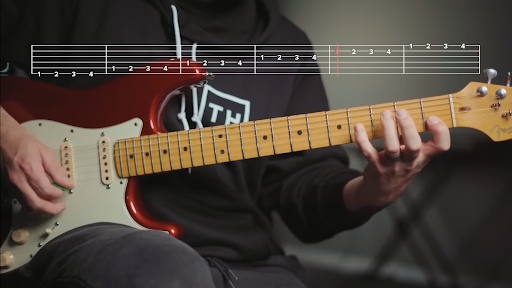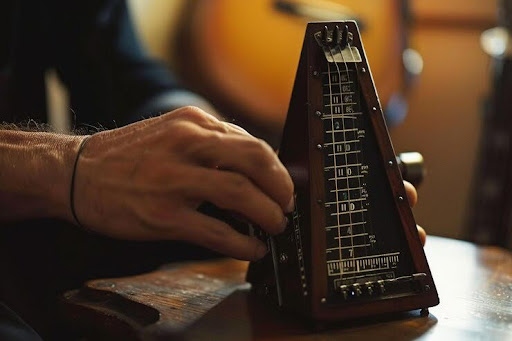How to Solo on Guitar? – Easiest Steps to Solo Success

There is nothing that can be more iconic about a song with an iconic solo. Not only does a solo make a song sound epic but it also sets up the mood. A good guitar solo can be an outstanding experience for the listener.
Some of the guitar legends earned the title of being one from their iconic solo. Yes, we mean Slash, Eric Clapton, Van Halen and so many more!
We have come across many instances where people said that playing solos was one of the main reasons why they started learning how to play a guitar in the first place.
However, learning how to play solos may not be as easy as you think. Even if you know all the notes it does not mean you can get to shredding right away. If you are serious about learning how to play solos there are some techniques you need to master first.
Don’t worry, here is where we come in to teach you the art of soloing. If you want to know where to start, what to do, and how to do it, follow this guide we prepared for you today.
We will start with the basics you need to cover and move up gradually.
So grab your guitar and let’s get started!
Check out the 7 best iconic guitar solos of all time! From mind-blowing riffs to unforgettable melodies, these legendary solos have shaped music as we know it. Whether you’re a guitarist or just a fan of great tunes, these solos are sure to inspire. Dive in and experience the magic!
Quick Guide On Guitar Solos For Beginners
- Learn master scales (major, minor, pentatonic) and keys.
- Learn how keys help select a scale for solos.
- Learn to improvise
- Learn finger exercises like chromatic runs and hammer-ons/pull-offs.
- Build speed and accuracy with a metronome.
- Practice with backing tracks
- Learn to hear and visualize chord progressions and musical phrasing.
- Schedule practice sessions with warm-ups, scale practice, technique drills, and improvisation.
- Track progress and improvements through a journal.
- Jam and collaborate for fun
- Understand different playing styles and improve timing.
Understanding the Basics of Guitar Soloing
Before diving into the details, let’s discuss what you need to brush up on first.
Scales and Keys
The foundation of every guitar solo is a good understanding of scales and keys.
Scales are of three types, major, minor, and pentatonic which set the roadmap for writing a solo. Major Scales are upbeat and blend well with the pop and classic rock genres.
Minor Scales are used to portray deeper emotions and are often used in blues and jazz.
Pentatonic scales are very popular in solos and have a five-note structure.
- A major pentatonic scale is played by omitting the 4th and 7th notes from a major scale.
- A minor pentatonic scale is played by omitting the 2nd and 6th notes from a minor scale.
You can think of keys as the ‘home base’ for any music. With keys, you can figure out which scale will work best with the solo you have in mind. Writing and improvising a solo becomes much simpler when you have a good understanding of keys.
Fundamentals of Improvisation
You have to improvise the most when you are playing a solo. You can just play a solo from sheet music alone but when improvising, you add a personal flair to it. When you learn how to properly improvise on the go, you can create music on the fly.
To practice improvising a solo, you can try some of these exercises to practice building fluidity:
- Choose a Key: You can start with a C major an A minor or any other that you are comfortable with.
- Learn the Scale: Once you have the root note, memorize the scale patterns on the fretboard.
- Play Along: Download a backing track to practice playing the scale over it. You need to focus on understanding how different notes interact with the underlying chords.
- Repeat and Vary: Once you have one variation practiced, start skipping notes or playing them in different orders within the original structure to create a new order.
Developing Technique
Musical theory aside, you need to be technically well-versed when playing a solo. Here are some exercises and practice routines that can help you build technique.
Finger Exercises
When playing solo, your fretting fingers need to be strong and agile, ready for anything that gets thrown at you.
To build finger strength you can practice these exercises regularly:

- Chromatic Runs: In this exercise, you start with your index finger on the first fret on the low E string. From there you play each fret up to the fourth using one finger per fret. Every 4th note you move up the fret and back down. Make sure to firmly press each string using the tip of your fingers so that they sound clear. This helps build finger dexterity and flexibility.
- Hammer-Ons and Pull-Offs: In this exercise, you play a note and then use your finger to hammer onto the next fret without picking. You have to do the opposite for pull-offs where you pluck the string once and pull your finger off to play the lower note. This will help build finger strength over time.
Speed and Accuracy
Once you have a grip on the finger exercises you can move on to building speed to play more demanding quick solos.
To practice building speed you can check out these practice drills:

- Metronome Practice: Use a metronome at a slow tempo and start practicing the scales from before. Once you master this tempo gradually increase the speed and repeat. Increasing this incrementally will help build muscle memory and precision.
- Consistency Over Speed: The main goal should be to ensure the notes played sound clear. You should not rush through to complete the drill rather complete it with 100% accuracy.
Learning to Listen
Playing the guitar is not just about completing your part of the deal and wrapping up. You need to learn to listen to other musicians you play with to make sure the final set sounds pristine.
Training your Ears
To play a good guitar solo you must train your ear to anticipate upcoming chord progressions. This way you can mentally craft the solo in your head first and play smoothly without any fumbles.
- Backing Tracks: Backing tracks are a great way to practice solos. This helps you gather knowledge of musical contexts and improves your ability to sync with others in a band setting.
- Recognize Chord Progressions: Make a list of songs that have simple to complex chord progressions. Listen to these tracks over and over again and try to identify why the chords are placed the way they are. This way you can train your ear on how a solo is written based on the chord progression.
Phrasing and Expression
Phrasing refers to how notes are grouped.
Phrasing will help you understand why a solo is not just a random set of notes and how they carry emotion.
When listening to a guitar solo, pay attention to how the guitarist breaks up lines and phrases. Throughout the solo, see how the guitarist phrases each part to bring out different emotions.
You can bring forward different emotions through a solo with techniques like bends, vibrato, and dynamics. These expressive techniques can add a vocal quality to a solo.
If you think about David Gilmour’s 2, you can understand how powerful a solo can be. The first solo shows themes of restraint whereas the second part of the solo sounds more intense
Practicing with Purpose
During every practice session, you must have a purpose that will look into improving different angles of playing solos. Approach each session in a well-structured manner so that you can tick techniques off the list one by one.
Structured Practice Routines
For beginners, we suggest allocating a little less than an hour each day to practice different solo techniques.
Here is a practice drill you can follow:
- Warm-Up: Use the first 10 minutes of your session to practice light finger exercises or simple chord progressions. This should be a good warm-up exercise for what will follow.
- Scale Practice: For the next 20 minutes, focus on playing different scales like major, minor, and pentatonic. Make sure you play these scales on different parts of the fretboard.
- Technique Drills: Use another 20 minutes to try specific techniques such as hammer-ons, pull-offs, bends, and slides for expression.
- Improvisation: Once you have the above completed, use a backing track and improvise playing a solo in different ways. The more you deviate from the original while sounding good the better you will become at improvising.
We also recommended keeping a personal journal where you can track your progress. This helps keep you up to date on things you have mastered and things you need to work on.
Soloing Over Chord Progressions
You can also try practicing playing solos over chord progressions. Start by identifying the root notes of the chords used and play a solo using those notes. It is best to experiment with different types of progressions like a 12-bar progression for a blues solo or a II-V-I progression for jazz.
If you need a free backing track to practice solos, check out Guitar Voice’s list of where you can get some for free!
Alternatively, you can even search for your song of choice on YouTube!
Playing with Others
Once you have a grasp on the basics of playing a guitar solo, the best way to test your skills is to practice with others. Jamming with other fellow guitarists is not only fun but a great way to learn new things and keep yourself in check.
Different musicians have different expressive ways of playing a guitar. Usually, the techniques differ as each goes through their journey of learning the basics.
When you play with others you get real-time feedback that will help you build new techniques. In a band setting, you need to adapt to those around you. This means you need to keep your rhythm and timing in check, something crucial in playing any instrument.
If you want to jam with new people you can look into your local music clubs, open mic nights, or music education centers. These places sometimes host jam sessions which can be a great experience to have to grow as a musician.
Other than that you can even connect with like-minded people on online forums like Reddit, Facebook, and other music forums.
Collaborative Soloing
A very fun way to play solos with others is by playing collaborative solos. Trading solos with others can be a great way to develop solo chops.
Here you have to do: listen to the other guitarist and wait for your turn to play.
Try to build on the idea that the other soloist developed to create a cohesive musical conversation.
It is good to establish a cue for when to start and stop playing. It can be a simple nod or a specific chord change.
Remember to always be respectful of the other guitarist and try to show support to keep the session engaging and fun.
Exploring Different Styles of Soloing
Almost all genres of music have some sort of solo incorporated into them. Each differs in terms of play style and expression. Let’s look at some varieties of solos across genres.
Various Styles of Solos
- Blues: Blues solos have a lot of emotion and expression tied to them. They are usually technically complex and are playing on the pentatonic scale. For an iconic blues solo, you can listen to B.B. King’s “The Thrill is Gone”.
- Rock: Rock solos are full of energy and are usually crafted around the minor pentatonic scale. You get everything from fast picking to string bends and distortion. Eddie Van Halen’s solo in “Eruption” is a great example of what an iconic rock solo should sound like.
- Jazz: Jazz musicians are more sophisticated with their style of playing a guitar solo. They are made up of complex scales and modes and are heavily improvised. Miles Davis’ “So What” is a jazz solo that you must listen to to get a good understanding of what they are like.
- Funk: Funk guitarists focus on rhythm and groove when playing a solo. You have syncopated rhythms, repeated riffs, and an emphasis on the downbeat. Listen to Prince’s “Kiss” to see how funk guitar solos can be minimalistic yet so rhythmically precise.
Are Ready To Take A Shot At A Guitar Solo?
Guitar solos complete songs.
They are a way to express the emotion that is expressed through lyrics. It is not easy to master it but with time you can build your skills. Before learning how to play a guitar solo you must have a good grasp on musical vocabulary.
It can be a difficult journey to start but with enough practice, you can move up the ladder to playing a solo from scratch. We encourage fellow guitarists to share their thoughts and their journey with the community. There is no one method of learning but rather a mix of many different methods. So feel free to share tips in the comments below.
We need to start practicing, right?
Find Out The Best Online Guitar Lessons: Top 10 Platforms.
If you are here to learn from the best, consider checking out guitar lessons from Denny Zager himself! Here at Zager Guitars, we have a comprehensive lesson plan. We have a downloadable Guitar Lesson Library where you can learn everything from A-Z about playing the guitar and guitar solos.
Frequently Asked Questions
To begin learning how to play guitar solos you can start by learning the minor pentatonic scale. It is a five-note scale that is used in most music you listen to. Use a backing track to practice playing solos on this scale till you get comfortable enough to move on to another.
There is not one answer for how long it takes to learn a solo. If you have a good grasp on music literature you can understand the ins and outs of a solo. However, how quickly you can learn one depends on the time and effort you put in to master each section of the solo itself.
Technically, you can learn to play guitar solos without deep knowledge of music theory. Many guitarists can play solos by learning scale patterns and practicing them over progressions. However, you may face difficulty in improvising on that solo. When you have good knowledge of theory, you have more freedom to express yourself rather than just being stuck to the sheet.
Many beginners make the rookie mistake of overusing licks and phrases when learning to play solos. In some cases, they can even go off track and ruin the solos as they have little practice in maintaining rhythm and timing.
It is best to use a metronome to practice playing notes on the fretboard. Gradually increase the tempo and speed of playing each note clearly. We recommend practicing scales, arpeggios, and technical exercises to build muscle memory and finger flexibility. This will go a long way when trying to play fast solos.
